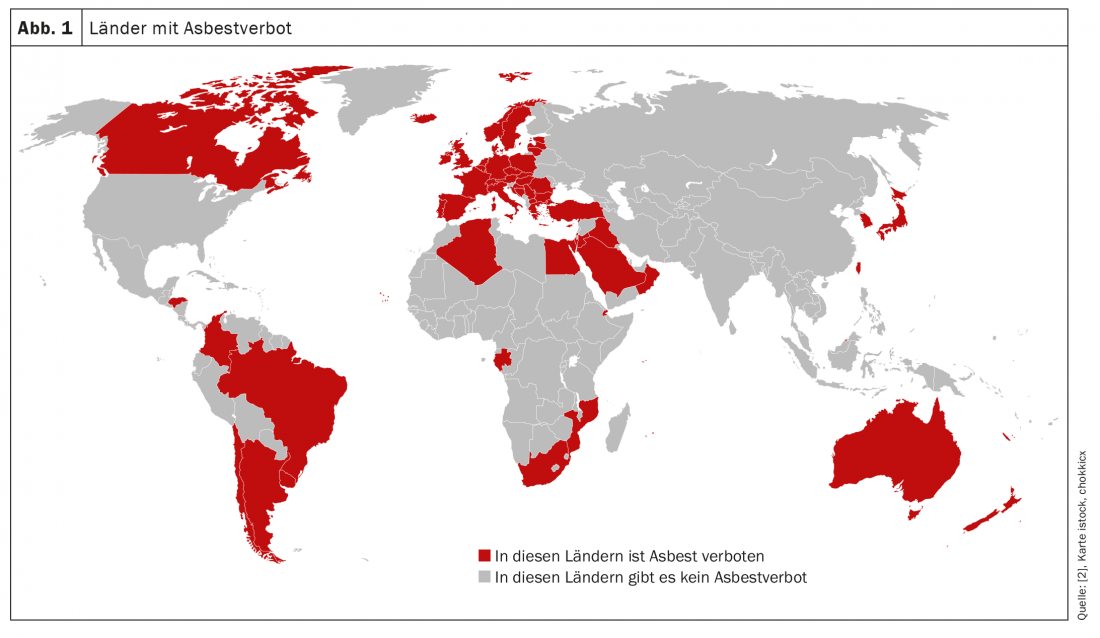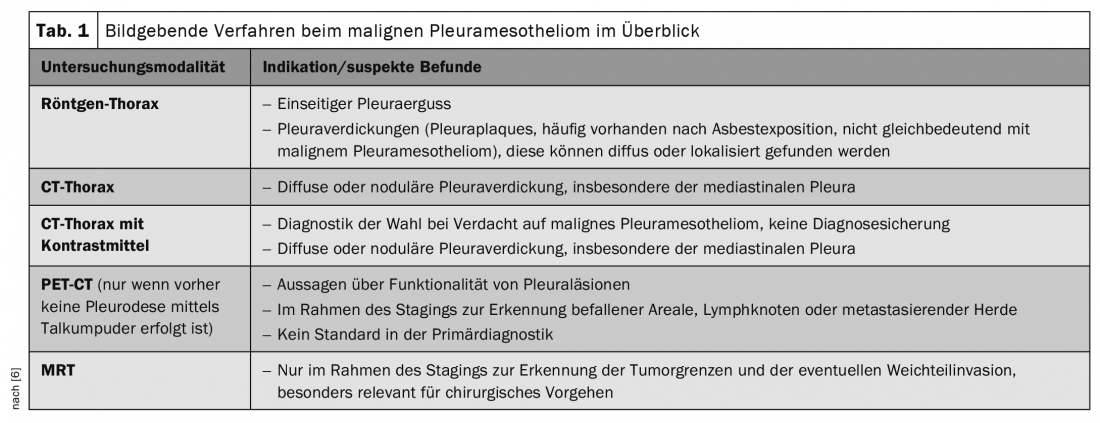Exposure to asbestos until 1990 is taking its toll – including the still-increasing number of malignant pleural mesotheliomas in Switzerland. The life expectancy of those affected is extremely low at around twelve months, and there is no suitable screening procedure. Nevertheless, with the recent approval of the first immunotherapeutic option for this disease, there is some hope.
The main risk factor is clear: asbestos exposure. However, although import and processing of asbestos have been banned in Switzerland since March 1, 1990, the number of cases of malignant pleural mesothelioma continues to rise [1,2]. Due to the latency period of 20 to 55 years, a maximum of new cases is not expected until 2030 [1]. Currently, about 200 diseases are diagnosed annually in Switzerland. Men are affected in 85% of cases and are usually over 60 years of age [3]. Unfortunately, the prognosis is extremely unfavorable with a median survival time of less than one year [4]. After decades of surgery and chemotherapy and, if necessary, radiotherapy forming the backbone of therapy, modern oncology drugs recently came into play for the first time with the approval of dual immunotherapy using ipilimumab/nivolumab – hopefully as a starting signal for further therapeutic improvements in the future.
Asbestos as a culprit
In 70-90% of affected individuals, malignant pleural mesothelioma is attributed to previous asbestos exposure [1]. Asbestos enters the lungs as dust, and the deadly fibers are produced by processing the material. Once inhaled, asbestos fibers are deposited in the respiratory tract and, because of their critical size, can neither be broken down nor excreted. The needle shape of the fibers allows them to migrate into the pleura and even cross over into the pleural space. As a result, fibrosis and, in the longer course, cancer occur, with lung, laryngeal, and pleural malignancies being the most common asbestos-related neoplastic sequelae [5]. The higher the cumulative dose, the higher the risk of disease [6]. But not all asbestos is created equal. For example, the most commonly used white asbestos (chrysotile) is considered less harmful than other types of asbestos such as blue asbestos (crocidolite). In general, the building material still used in large parts of the world – asbestos has so far been banned in only 67 countries (Fig. 1) [2] – is a group of naturally occurring inorganic crystalline minerals, so-called silicates. With excellent heat resistance and best insulating properties [5].

Malignant pleural mesothelioma following occupational exposure to asbestos is considered an occupational disease and is thus covered by compulsory accident insurance in Switzerland. However, since exposure often dates back several decades, reappraisal is not always easy. Those who have had non-professional contact with the material are less financially secure. In the meantime, support services for affected persons are increasingly available, such as the Foundation for the Compensation Fund for Asbestos Victims (EFA) [7].
The role of genes
In addition to asbestos exposure, several genetic alterations have also been identified over the past years as risk factors for the development of malignant pleural mesotheliomas, most notably BAP1 (BRCA-1-associated protein 1) mutations, both at the protein and DNA levels. These are often observed in families with higher than average incidence, in young patients, and in the presence of second tumors [6,8]. Overall, BAP1 mutations are present in approximately two-thirds of sporadic mesotheliomas [9]. Certain regions of Turkey, which are highly contaminated with the naturally occurring asbestos fiber erionite, appear to be particularly affected. Due to this occurrence as well as hereditary BAP1 mutations, up to 50% of people die from mesothelioma in some areas [9]. Inactivating mutations of tumor suppressor genes such as CDKN2A, LATS-1, or NF2 may also promote malignant pleural mesothelioma [9].
Clinical presentation and diagnostics
Due to nonspecific and mostly late-occurring symptoms, the disease is often only discovered in advanced stages. In addition to dyspnea, cough, and thoracic pain, weight loss is most common. Recurrent pleural effusions occur in about one-third of patients. Later on, hemoptysis, dysphagia, hoarseness and Horners syndrome are also not uncommon [10]. Mesothelioma disease should be considered, especially in cases of unilateral pleural effusions or pleural thickening [11].
First and foremost in the diagnostic process is the question of possible asbestos exposure in the past. Family history also plays an important role. If asbestos exposure remains unexplained, asbestos fibers can be detected by electron microscopy. However, this does not confirm the diagnosis of pleural mesothelioma, only exposure. This requires bronchoalveolar lavage or lung biopsy to obtain material [4]. As early as possible, referral to a specialized center should be made when mesothelioma is suspected.
In addition to imaging techniques, histopathologic workup of biopsy specimen and pleural effusion is of particular importance. Tumor markers currently do not play a role in diagnosis and also in the assessment of progression [6]. Imaging by chest x-ray, ultrasound, and/or CT can be used to confirm the suspected diagnosis and determine the optimal biopsy site. The final diagnosis, however, can only be confirmed by histopathological tissue examination. A CT thorax with contrast medium is recommended as the initial imaging diagnosis of choice, where malignant pleural mesothelioma characteristically presents as diffuse or nodular pleural thickening (Table 1). In the course of staging, PET-CT and possibly MRI are also used. In any case, staging should also include endobrachial ultrasound and mediastinoscopy to determine lymph node status before initiating therapy. Contralateral VATS (video-assisted thoracoscopies) and laparoscopies are also used [6]. The staging is done according to the international TNM classification.

To confirm the diagnosis, biopsies are taken from morphologically conspicuous and inconspicuous pleural areas, either by VATS, ultrasound-guided needle biopsy, or open pleural biopsy [6]. Pure cytologic examination of pleural effusion cannot replace biopsy due to lack of sensitivity [4]. Immunohistochemical and molecular genetic analyses are performed as part of the histopathological workup. These serve on the one hand to prove the mesothelial origin and on the other hand to differentiate from other malignant changes. In addition, the histological subtypes are associated with different surface proteins [8]. In general, epithelioid, biphasic, and sarcomatoid subtypes are distinguished on the basis of histomorphologic growth patterns, with epithelioid pleural mesotheliomas shown to be more prognostically favorable than sarcomatoid [12].
Therapy: The road to modernity
To date, no uniform standards exist for the treatment of malignant pleural mesothelioma. One thing is clear, however: monotherapy does not seem to be sufficient [13]. The goal of treatment is – if possible – a macroscopically complete resection in a multimodal treatment concept. In this setting, adjuvant or neoadjuvant chemotherapy using platinum plus pemetrexed has been the mainstay. Gemcitabine proved to be similarly effective with significantly worse tolerability [13]. The addition of bevacizumab is a possibility but is not approved in Switzerland [14]. Currently, no maintenance therapy is recommended, and well-tested options for second-line therapy are lacking [6]. In principle, patients should receive preferential treatment at specialized centers and have access to clinical trials [6].
In addition to surgery and chemotherapy, radiotherapeutic procedures are also used. These are used, for example, to relieve pain and may have an impact on the risk of recurrence, which is currently being investigated in studies [6]. Radical irradiation of the entire tumor is generally not recommended outside of studies because of the usually complex tumor spread and the resulting dose exposure. Biopsy collection sites should not be irradiated prophylactically to prevent tumor cell seeding, contrary to previous assumptions [6].
Radical surgical therapy is generally reserved for those patients without sarcomatoid histology. Further prerequisites are a lymph node status N<2 and a UICC stage <IV. This means that no metastases must be present [6]. Not tumor-rest-free surgery is targeted, but macroscopically complete resection. Depending on the situation, the procedures that can be considered are extrapleural pneumonectomy (EPP), lung-preserving pleurectomy and decortication (P/D), and partial pleurectomy [8]. The bottom line is that the benefit of these surgeries remains unclear; currently, the MARS2 trial is investigating the benefit of lung-preserving pleurectomy and decortication versus proceeding without surgery. Surgical interventions are also important in the context of a palliative treatment concept. For example, recurrent pleural effusions may be treated with pleurodesis with talcum powder [15].
In the field of systemic therapy, a breakthrough was recently achieved after a long lull. For example, the CheckMate-743 trial showed a benefit of first-line treatment with both checkpoint inhibitors, nivolumab and ipilimumab, in the palliative setting [16,17]. Dual immunotherapy has already been approved due to the convincing results in non-epithelioid histology as well as epithelioid histology and PD-L1 expression ≥1% [14]. In the study, it resulted in a median overall survival (OS) of 18.1 months, compared with 14.1 months in the chemotherapy group (hazard ratio 0.74, p=0.002) [17]. This first significant success in the field of modern oncological therapies raises further questions. Thus, the combination of chemotherapy and immunotherapy is among the options under discussion, as well as possible new second-line options. And not only could additional new agents soon find their way into the treatment of malignant pleural mesothelioma, but also alternative routes of administration. As the high rate of local recurrence is a relevant problem, localized therapy options such as intracavitary therapy are increasingly coming into focus. For example, the INFLuenCe-Meso phase II trial is currently underway at the University Hospital Zurich to evaluate the safety and efficacy of intracavitary chemotherapy after surgical resection [13].
Literature:
- Beeler P, et al: Data sources on the incidence of malignant pleural mesothelioma in Switzerland since 2001. ASU Journal of Medical Prevention. 2021; 09.
- Unia: 30 years of asbestos ban. www.unia.ch/de/arbeitswelt/von-a-z/asbest/30-jahre-asbestverbot (last accessed Sept. 30, 2021).
- Krebsliga Schweiz: Cancer in Switzerland: important figures. Status December 2020. www.krebsliga.ch/fileadmin/downloads/sheets/zahlen-krebs-in-der-schweiz.pdf (last accessed Sept. 30, 2021).
- Scherpereel A, et al: Guidelines of the European Respiratory Society and the European Society of Thoracic Surgeons for the management of malignant pleural mesothelioma. Eur Respir J. 2010; 35(3): 479-495.
- Duel T: Oncology Guide – Pleural Mesothelioma (Chest Pleural Cancer) | Causes, Diagnosis, and Treatment.www.oncology-guide.com/erkrankung/pleuramesotheliom (last accessed 09/30/2021).
- Scherpereel A, et al: ERS/ESTS/EACTS/ESTRO guidelines for the management of malignant pleural mesothelioma. Eur Respir J. 2020; 55(6).
- EFA Foundation. www.stiftung-efa.ch (last accessed Sept. 30, 2021).
- Baas P, et al: Malignant pleural mesothelioma: ESMO Clinical Practice Guidelines for diagnosis, treatment and follow-up. Ann Oncol. 2015; 26 Suppl 5: v31-9.
- Duel T: Systemic therapy of pleural mesothelioma. Drug therapy. 2017; 35(06).
- Malignant pleural mesothelioma – symptoms, treatment, and physician search: Deutscher Verlag für Gesundheitsinformation, Heidelberg, Germany; www.leading-medicine-guide.ch/erkrankungen/tumoren/mesotheliom#topics (last accessed Sept. 30, 2021).
- Gill RR: Imaging of mesothelioma. Recent Results Cancer Res. 2011; 189: 27-43.
- Husain AN, et al: Guidelines for pathologic diagnosis of malignant mesothelioma: 2012 update of the consensus statement from the International Mesothelioma Interest Group. Arch Pathol Lab Med. 2013; 137(5): 647-667.
- Malignant pleural mesothelioma therapy. www.usz.ch/fachbereich/thoraxchirurgie/angebot/malignes-pleuramesotheliom (last accessed Sept. 30, 2021).
- Swissmedic Drug Information. www.swissmedicinfo.ch (last accessed Sept. 30, 2021).
- Bielsa S, et al: Tumor type influences the effectiveness of pleurodesis in malignant effusions. Lung. 2011; 189(2): 151-155.
- Nowak AK, Jackson A, Sidhu C: Management of Advanced Pleural Mesothelioma-At the Crossroads. JCO Oncol Pract. 2021: Op2100426.
- Baas P, et al: First-line nivolumab plus ipilimumab in unresectable malignant pleural mesothelioma (CheckMate 743): a multicentre, randomised, open-label, phase 3 trial. Lancet. 2021; 397(10272): 375-386.
InFo ONCOLOGY & HEMATOLOGY 2021; 9(5): 32-33.











